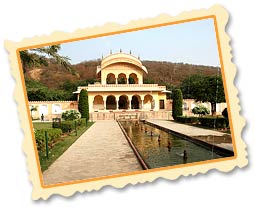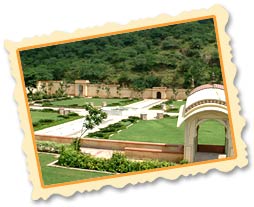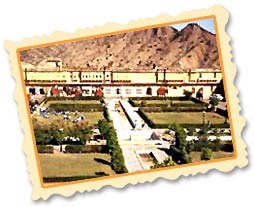Kanak Vrindavan Valley
| Location: | Adjoining Amer Fort, On Amer-Jaipur Road |
| Famous for: | Breathtaking views of the cityand plush greenery |
| Built By: | Maharaja Sawai Jai Singh |
| Visiting Hours: | 8:00 AM - 5:00 PM |
 The
Kanak Vrindavan Valley is an exotic place in Jaipur, and is located on
the way to the Amer Fort. Nuzzled at the bottom of the Nahargarh hill,
the garden complex is surrounded by popular tourist spots such as the
Amer Palace, Jaigarh fort and blankets of lush greenery. History states
that the garden was given its name by Maharaja Sawai Jai Singh,
approximately 280 years ago, when the complex was built. The term
'Vrindavan' was coined because the garden resembled the descriptions of a
mythological place, where Lord Krishna is believed to have resided. The
garden is often compared to the valley of 'Vrindavan' and the king,
subsequently, consecrated an idol of Lord Krishna in a special complex
in the Kanak Vrindavan valley called the 'Shri Govind Deoji' complex.
The garden encompasses a temple, a series of fountains and intricate
marble workmanship. Managed by the Government of Rajasthan, the Kanak
Vrindavan Valley is the ideal tourist destination for those wanting to
relish the beautiful, green scenery, and the magnificent structures of a
bygone era.
The
Kanak Vrindavan Valley is an exotic place in Jaipur, and is located on
the way to the Amer Fort. Nuzzled at the bottom of the Nahargarh hill,
the garden complex is surrounded by popular tourist spots such as the
Amer Palace, Jaigarh fort and blankets of lush greenery. History states
that the garden was given its name by Maharaja Sawai Jai Singh,
approximately 280 years ago, when the complex was built. The term
'Vrindavan' was coined because the garden resembled the descriptions of a
mythological place, where Lord Krishna is believed to have resided. The
garden is often compared to the valley of 'Vrindavan' and the king,
subsequently, consecrated an idol of Lord Krishna in a special complex
in the Kanak Vrindavan valley called the 'Shri Govind Deoji' complex.
The garden encompasses a temple, a series of fountains and intricate
marble workmanship. Managed by the Government of Rajasthan, the Kanak
Vrindavan Valley is the ideal tourist destination for those wanting to
relish the beautiful, green scenery, and the magnificent structures of a
bygone era.History
The Kanak Vrindavan Valley was built approximately 280 years ago by Maharaja Sawai Jai Singh of Jaipur. The beautiful, green valley is encircled by the Aravalli hills and is said to resemble mythological Vrindavan; the abode of Lord Krishna and the place where he frolicked with his Gopis. The Kanak Vrindavan Valley was built for recreational purposes by the king. It is also believed to be a sacred spot where the waters from several important rivers merged to carry out the holy 'Ashwamedh Yagna'. The Govind Deoji temple was built around the same time, and is believed to house the incarnation of Lord Krishna.
Layout/Specialty
The Kanak Vrindavan Valley is a picturesque spot located at the foot of the Nahargarh hills, and is flanked by unique trees. Apart from the blankets of trees and lawns, the Kanak Vrindavan Valley is, in fact, a beautiful garden flanked with intricate 'chhatris', exquisite mirror and 'jali' work on the walls of the Govind Deoji temple, and a series of fountains. The garden is divided into eight sections, and is famous for a fountain called 'Parikrama', which is carved out of a single slab of marble. This workmanship from a bygone epoch and the dexterity of the artwork surrounding the garden is what adds to the beauty of the place. The 'Garba Griha' ('seat of the lord') is also placed inside the temple complex and is etched with delicate 'panni' work. The evergreen gardens at the Kanak Vrindavan Valley offer a stupendous view of Jaipur and other nearby attractions such as Amer Fort and the Dharbawati River. The breathtaking scenery has often been used as a background for many Bollywood films in India.
Nearby Tourist Attractions
- Amer Fort
- Jal Mahal
- Elephant Park
- Jaigarh Fort
The Kanak Vrindavan Valley not only offers beautiful
sights for the avid traveler, but is also an ideal location for a picnic
with family. The location also offers a bird's eye view of the city of
Jaipur and its exotic monuments such as the Jal Mahal. For those seeking
tranquility and some peace of mind, the Kanak Vrindavan Valley is the
ideal place to be.
Sisodia Rani Ka Bagh
| Location: | 10 km from Jaipur city |
| Built by: | Maharaja Sawai Jai Singh |
| Built in: | 1728 AD |
| Famous for: | Radha-Krishna Murals |
| Visiting Hours: | 8 AM to 6 PM |
 Sisodia
Rani Ka Bagh is situated at a distance of 10 km from Jaipur city and
lies on Jaipur-Agra highway. This royal garden was built by Maharaja
Sawai Jai Singh in 1728 for his second queen Sisodia. Sisodia Rani
Garden is adorned with beautiful wall paintings of Radha-Krishna love
story. The paintings on the wall and the narrative details truly
represent eternal love and befits the essence of this garden which
itself is a symbol of love. This lush green royal garden is replete with
flowerbeds, foliage, beautiful water fountains, pavilions, galleries,
iridescent water channels and murals. It is said that in the olden days,
the garden served as an ideal getaway for the Queen. Sisodia Rani Ka
Bagh is multi-tiered and makes an interesting tourist spot.
Additionally, the garden breathes life to the desert soil of Jaipur.
Sisodia
Rani Ka Bagh is situated at a distance of 10 km from Jaipur city and
lies on Jaipur-Agra highway. This royal garden was built by Maharaja
Sawai Jai Singh in 1728 for his second queen Sisodia. Sisodia Rani
Garden is adorned with beautiful wall paintings of Radha-Krishna love
story. The paintings on the wall and the narrative details truly
represent eternal love and befits the essence of this garden which
itself is a symbol of love. This lush green royal garden is replete with
flowerbeds, foliage, beautiful water fountains, pavilions, galleries,
iridescent water channels and murals. It is said that in the olden days,
the garden served as an ideal getaway for the Queen. Sisodia Rani Ka
Bagh is multi-tiered and makes an interesting tourist spot.
Additionally, the garden breathes life to the desert soil of Jaipur.History Of Sisodia Rani Ka Bagh
Sisodia Rani Ka Bagh was built by Maharaja Sawai Jai Singh in 1728 for his second queen, a princess from Udaipur. The Maharaja presented this royal garden to his beloved queen to serve as a perfect retreat place for her. Away from hustle bustle of court politics, the garden offered a peaceful haven for Sisodia Rani. The garden is filled with various plant species, lush green shrubs and scented flowers. The walls are decorated with murals of Radha-Krishna, symbolizing the love that the Maharaja had for his beloved queen Sisodia.
Architectural Layout
The layout of this royal garden is a beautiful mix of traditional Indian designs and Mughal style. One can see traditional Indian designs, such as the use of pavilions and spires, in the garden. The walls are decked with beautiful paintings of the eternal lovers, Radha and Krishna. The flowerbeds, fountains and water channel running through the garden and merging at the centre are quite symbolic of Mughal style. There are natural springs and shrines dedicated to Lord Shiva, Vishnu and Hanuman in the vicinity of this royal garden.
Best Time To Visit
The best time to visit Sisodia Rani Ka Bagh is between July and March as this is when the state witnesses monsoons followed by winters which are ideal for a visit to Jaipur, known for its extreme climatic conditions.
Nearby Tourist Attractions
The other tourist attractions near Sisodia Rani Ka Bagh are Galtaji Temple, Statue Circle, Birla Temple, Govind Dev Ji Temple, Moti Dungri Ganesh Temple and Jauhari Bazaar.
How To Reach
Sisodia Rani Ka Bagh is well connected to Jaipur by roads and can be reached by local buses that ply from Jaipur to Sisodia Rani Ka Bagh. You can also hire taxi or cab service from Jaipur to reach Sisodia Rani Ka Bagh.
Sisodia Rani Ka Bagh is one of the most favorite tourist destinations in Jaipur city. Here, one can discover a tranquil atmosphere and pavilions adorned with romantic murals of Radha and Krishna. The garden, which was once known as sanctum of Queen Sisodia, can today be enjoyed by everybody who visits it.
Vidyadhar Garden Jaipur
| Famous for: | Murals of Lord Krishna, flower beds, breathtaking scenery and galleries |
| Built In: | 1988 AD |
| Visiting Hours: | 8:00 AM - 5:30 PM(Open all days) |
 The
Vidyadhar garden is a pristine garden located in the heart of Jaipur.
One of Jaipur's best-preserved gardens, this picturesque garden is
aesthetically designed and was built in the memory of Jaipur's chief
Architect, Vidyadhar Bhattacharya. Apart from the crystal waters, the
tranquil lakes, flower beds and well-maintained gardens, the Vidyadhar
Garden has a lot to offer. Nestled in the lap of a popular valley in
Jaipur, the garden offers a panoramic view of the city and is the pride
of Jaipur's heavy heritage and culture. The garden was strategically
built to the decrees of the ancient 'Shilpa Shasthra' and is situated
close to the Sisodia gardens. The garden is the perfect amalgamation of
contemporary Hindu and Mughal styles with its wonderful, sylvan lakes,
terraced lawns, fountains and the majestic pavilions that house Lord
Krishna's murals and paintings. Managed by the Government of Rajasthan,
the Vidyadhar Garden is a vast expanse of imperial architecture and
dazzling greenery.
The
Vidyadhar garden is a pristine garden located in the heart of Jaipur.
One of Jaipur's best-preserved gardens, this picturesque garden is
aesthetically designed and was built in the memory of Jaipur's chief
Architect, Vidyadhar Bhattacharya. Apart from the crystal waters, the
tranquil lakes, flower beds and well-maintained gardens, the Vidyadhar
Garden has a lot to offer. Nestled in the lap of a popular valley in
Jaipur, the garden offers a panoramic view of the city and is the pride
of Jaipur's heavy heritage and culture. The garden was strategically
built to the decrees of the ancient 'Shilpa Shasthra' and is situated
close to the Sisodia gardens. The garden is the perfect amalgamation of
contemporary Hindu and Mughal styles with its wonderful, sylvan lakes,
terraced lawns, fountains and the majestic pavilions that house Lord
Krishna's murals and paintings. Managed by the Government of Rajasthan,
the Vidyadhar Garden is a vast expanse of imperial architecture and
dazzling greenery.History
The Vidyadhar garden is one of the best-preserved gardens in Jaipur and is also the pride of the city. The garden was built in the memory of Vidyadhar Bhattacharya, who was the architect of the 'Pink City' of Jaipur. As a chief architect to Maharaja Sawai Man Singh, the architect was known for his designs, elaborate architecture and the dexterity with which he could create visual wonders. The garden, built in 1988, was designed according to the ancient texts of the 'Shilpa Shastra', the ancient Indian line of architecture which Vidyadhar used while planning the city of Jaipur. The garden was believed to have been a vineyard, situated in the vicinity of the Sisodia gardens.
Architectural Layout
The Vidyadhar garden is home to beautiful fountains, tiers of terraced gardens, several galleries, royal pavilions and scenic lakes. Built according to the rules of the 'Shilpa Shastra', the Vidyadhar garden also displays ornate frescos with murals and images of Lord Krishna, and well-maintained flower beds. The walls are engraved with intricate lattice work, and mirror work in the temple and the architecture of the place reflects the casual mix of Mughal architecture, with typical Rajput-influenced interiors. The marriage between the two cultures clearly echoes off the landscape and the design of this garden. The garden is known for its numerous fountains, spontaneous peacock dancing, bird watching and the beautifully, terraced flowerbeds.
Nearby Tourist Attractions
- Sisodia Gardens
- City Palace
- Jal Mahal
- Jantar Mantar
The Vidyadhar Garden was constructed in the memory of
Vidyadhar Bhattacharya. The garden is a popular tourist attraction and
is a pleasant getaway for those seeking a peaceful escape. The garden is
a picturesque attraction in the heart of Jaipur and it is a must-see
destination for tourists in this city.
No comments:
Post a Comment